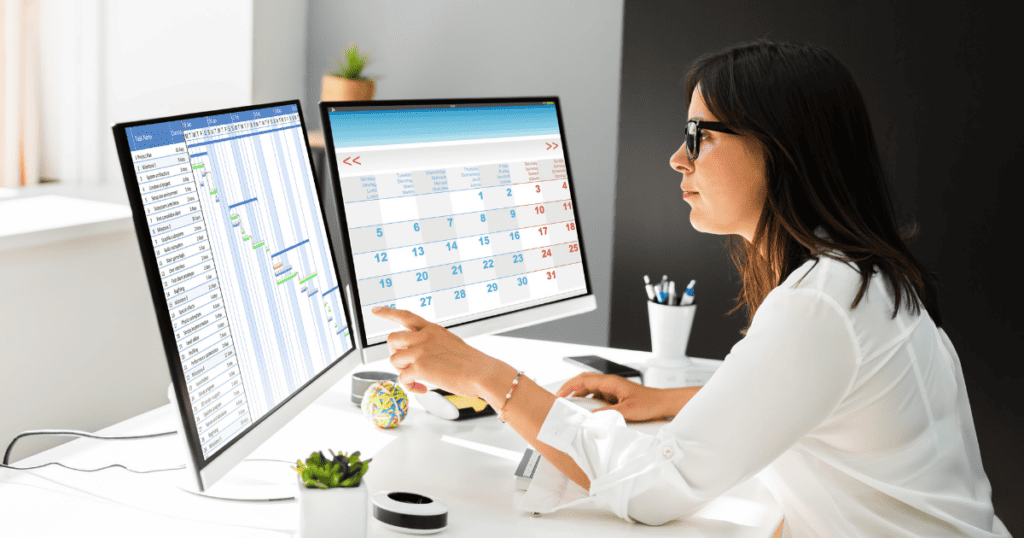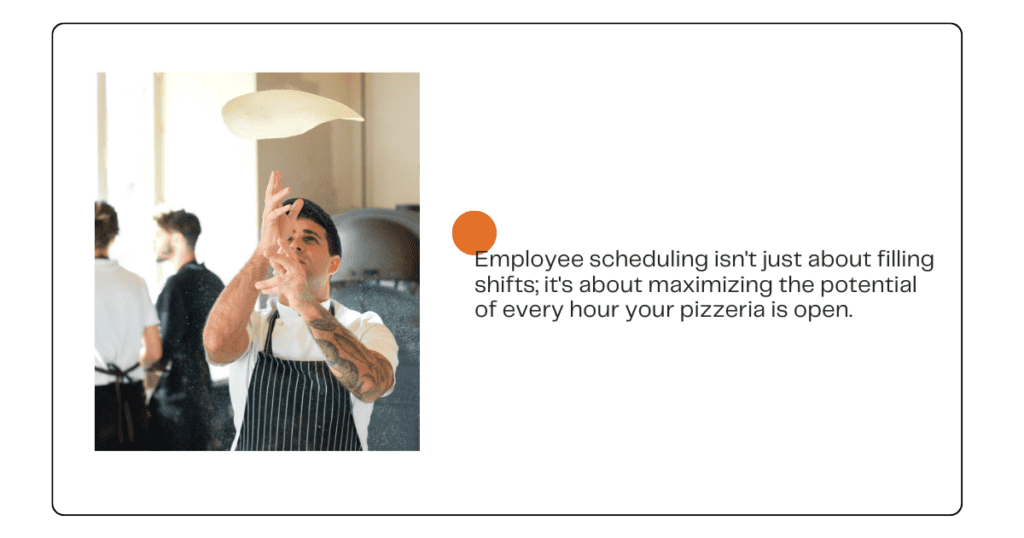In our Ignite Growth series, we’ve explored how pizzeria and restaurant owners can enhance their businesses. We recently explored how to improve the customer experience and customer retention strategies. Today, we’re shifting our focus to another element related to growth: employee scheduling and training.
Recognizing that we have much to cover on these subjects, we’ve divided it into two articles. Our goal today is to provide practical insights and actionable strategies on the art and science of employee scheduling and explain its role in fueling pizzeria growth.
How Employee Scheduling Is Connected to Growth

Often seen as a mere administrative task, employee scheduling can be a big part of a pizzeria’s growth strategy. Getting your scheduling right means your operations run smoothly, customers are served promptly, and staff morale remains high. On the other hand, missteps in scheduling can cause operational bottlenecks, longer wait times for customers and burnt-out employees.
Here are some compelling reasons why optimized employee scheduling is directly linked to growth:
- Operational Efficiency: With proper scheduling, there’s always the correct number of staff on hand. This reduces the chance of being understaffed during busy times and excess staffing during slower periods.
- Customer Satisfaction: When your pizzeria is adequately staffed, customers receive their orders faster, and service is more attentive, leading to a better overall experience.
- Employee Morale: Predictable and fair scheduling allows employees to balance work with personal commitments. This leads to increased job satisfaction and lower turnover rates.
- Cost Management: Efficient scheduling helps control labor costs, ensuring you’re not overstaffed or paying unnecessary overtime.
- Flexibility & Responsiveness: With a well-thought-out schedule, adjusting and accommodating for unforeseen circumstances, such as large group bookings or local events that drive traffic, is easier.
To sum it up, employee scheduling isn’t just about filling shifts; it’s about maximizing the potential of every hour your pizzeria is open. By giving this aspect of your business the attention it deserves, you position your pizzeria to operate at its peak potential.
How to Make a Schedule for Employees: 7 Tips

Creating a workable schedule for your pizzeria staff will ensure that all shifts are covered, and your business runs like a well-oiled machine. Here are some practical tips on how to make a schedule for employees in your pizza business.
1. Assess Your Peak Times
Understanding the busiest times for your pizzeria is the cornerstone of effective scheduling. Analyze past sales data, customer flow, booking reservations, and other data to identify patterns. For instance, weekends might bring a surge of customers, especially during lunch and dinner hours, or maybe Tuesdays are unexpectedly busy due to your weekly special.
Once you’ve pinpointed these peak periods, schedule enough staff to manage the rush. Conversely, you can afford to have a leaner team during slower times. Adjusting staffing according to demand means customers always receive timely service and employees aren’t overwhelmed or idle.
2. Consider Employee Availability and Preferences
Staff members will have different availability and preferences, especially if some are part-timers or students. Start by getting a clear understanding of when each person can work. This helps to avoid conflicts and boosts staff morale. When employees feel their needs are considered, they are more likely to be engaged and committed when on the clock.
Catering to everyone’s preferences is not always possible. However, aiming for a balance where you respect their preferences while meeting the pizzeria’s needs can create a positive work environment and reduce turnover.
3. Rotate Shifts Fairly

It’s important that no particular employee is always stuck with the less-desired shifts (unless, of course, that is their preference or availability). For instance, consistently scheduling someone for the closing shift or on weekends might lead to burnout and dissatisfaction. Try to rotate these shifts among the team so everyone gets their fair share of preferred and less preferred slots.
By rotating shifts, employees get a varied experience, and they are versatile in handling different times of the day or week. Rotation helps build a more adaptable and skilled workforce for your pizzeria.
4. Use Technology to Your Advantage
While manual scheduling on paper or spreadsheets can work, investing in employee scheduling software can be a game-changer. Many modern tools offer features like automatic conflict detection, employee availability settings, and even forecasting based on historical data.
Creating and adjusting the schedule becomes quicker and more efficient with the right tool. Plus, many of these tools allow employees to check their schedules online, request changes, or swap shifts, further reducing managerial work.
But don’t stop at scheduling software. Expanding your technology toolkit can bring further efficiency to your pizzeria. Consider an online ordering platform or a dedicated app. By allowing customers to place orders digitally, you can reduce the staff needed to answer phones. Also, adopting a cloud-based phone system integrated with your CRM can drastically improve the order-taking process. When a repeat customer calls, their details are instantly available. This speeds up the order process and allows you to offer a personalized touch.
5. Incorporate Cross-Training into Your Scheduling

Cross-training (teaching employees multiple roles within your pizzeria) is more than just a training tool; it’s a scheduling strategy. A server who can step into the kitchen during a rush or a cook who can handle the register on a busy night gives you a dynamic team ready to tackle unexpected challenges. The flexibility of a cross-trained team provides peace of mind for owners and managers who know they have a roster of adaptable staff to turn to.
In a fast-paced pizza restaurant, situations can change in an instant. Maybe a large party walks in unexpectedly, or a staff member calls in sick. Cross-trained staff can transition between roles so service quality remains high and wait times low. Moreover, employees often appreciate the variety and skill development that comes with learning different aspects of the business, which can lead to increased job satisfaction and morale.
6. Plan for Emergencies
Emergencies are bound to happen, whether it’s a call-off, an equipment malfunction, or an unexpected rush due to a local event. Preparing for unforeseen circumstances is crucial, so you must have a contingency plan. This might mean having a few part-time or on-call staff members who can come in when things get hectic and ensuring that there’s always a manager or experienced employee on duty who can handle a crisis.
It’s also wise to maintain open communication channels. Encourage staff to notify management as soon as they know they can’t make a shift so you have ample time to find a replacement or adjust the schedule. A smooth response to emergencies reassures staff and customers that your pizzeria is well-managed and reliable.
7. Review and Adjust Regularly

No matter how perfect a schedule may seem, there’s always room for improvement. Regularly review and refine your schedule as needed. This means revisiting sales data, noting any changes in customer behavior, and continuously seeking feedback from staff.
A schedule that worked perfectly during the summer may not be as effective in the winter. Or maybe you’ve noticed that Monday evenings, previously slow, are picking up because it’s football season. By being proactive and willing to adjust, you ensure your pizzeria remains efficient and well-equipped to handle whatever comes its way.
Optimize Your Employee Scheduling
Creating an effective employee schedule takes time, but with these tips, you’re well on your way. Remember, a well-planned schedule doesn’t just benefit your business; it’s also a sign of respect and appreciation for your team’s time and effort.
And for our next article, we will keep the focus on your team. We’ll discuss how you can ignite growth by optimizing your employee training, so be sure to check it out.



